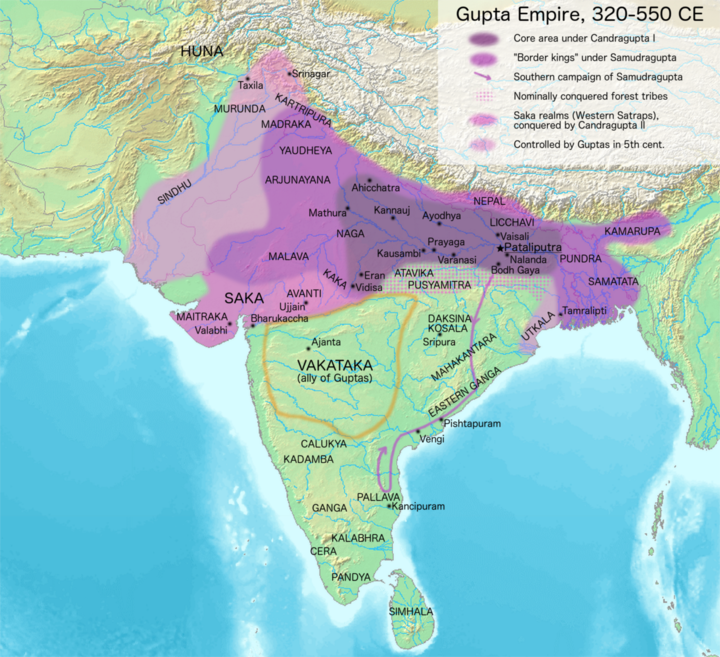The Rise and Growth of the Gupta Empire
Hello Students,
Ancient India is a very important topic for UPPSC PCS and other Uttar Pradesh Exams. In this Article we will cover the topic Gupta rule in ancient India. It is one of the most commonly asked part of syllabus of Ancient History.
All the Best!!
The Rise and Growth of the Gupta Empire
Background
After the fall of Mauryan empire, the Kushans in the North and Satavahanas in the south had held power. Gupta empire replaced the Kushans in the North with its centre of power at Prayag and gave political unity for more than a century (335AD-455AD). It was founded by Sri Gupta. Gupta strength laid in the use of horses and material advantage of fertile land and natural resources abundant region.

- Chandragupta I (319-334 AD)
- He was the first great ruler of Gupta Dynasty. He assumed the title Maharajadhiraja. Married Licchhavi princess
- Started the Gupta Era by 319-20 AD
- The original type of Gold coins Dinaras was issued.
- Samudragupta (335-380 AD)
- He followed a policy of violence and conquest which led to the enlargement of Gupta empire
- Harisena, his court poet, vividly mentions his military exploits in Allahabad inscriptions
- He reached Kanchi in the south which was ruled by Pallavas
- Meghavarman, the ruler of Srilanka, sent a missionary for permission to build a Buddhist temple at Gaya
- Samudragupta is called as Napoleon of India
- Chandragupta II (380-412 AD)
- He adopted the title Vikramaditya
- He conquered Malwa and Gujarat which provided him access to the sea which enabled trade and commerce. Ujjain was made as the second capital
- His court was adorned by the Navaratnas including Kalidasa and Amarasimha.
- His exploits are glorified in Iron Pillar at Qutub Minar
- Chinese pilgrim Fa-Hsien (399-414AD) visited India during his period.
Life in Gupta Age
- System of Administration
- They adopted Pompous titles such as Paeamabhattaraka and Maharajadhiraja.
- The administration was highly decentralized with feudal lords ruling over minor provinces
- Civil and criminal laws were highly demarcated
- Kumaramatyas were the most important officers. But Guptas lacked elaborate bureaucracy like Mauryas. These offices also became hereditary in nature.
- Grant of fiscal and administrative concessions to priests was also in practice. Agrahara grants and Devagraha grants were practised.
- Trends in trade and agrarian economy
- Guptas issued a large number of Gold coins which were called as Dinars
- There was a decline in the long distance trade with Romans which led to lesser gold content in the Dinars.
- Land grants made to the priests brought many virgin lands under cultivation
- Social developments
- Brahmana supremacy continued during Gupta period
- The Huns came to be recognized as one of the 36 clans of the Rajputs
- The position of Shudras improved as they were permitted to hear Ramayana, Mahabharata and Puranas
- The number of untouchables, the Chandalas, increased
- The position of women improved as they were permitted to hear Ramayana, Mahabharata and worship Krishna. But the first example of Sati also appears in the Gupta period.
- State of Buddhism
- Buddhism did not receive royal patronage in Gupta Period, still, stupas and Viharas were constructed and Nalanda became a centre for Buddhist learning
- Origin and growth of Bhagavatism
- Worship of Vishnu and Narayana merged to form Bhagavatism or Vaishnavism
- It was marked by Bhakti (loving devotion) and Ahimsa
- Religious teachings were mentioned in Bhagavadgita, Vishnu Purana and Vishnu Smriti
- Idol worship became a common feature of Hinduism
- Gupta rulers followed a principle of tolerance
- Art
- Gupta period is called the Golden age of ancient India. Art was mostly inspired by Religions.
- Rock cut caves – Ajanta, Ellora and Bagh caves
- Structural temples – Dashavatar temple of Deogarh, Laxman temple of Sirpur, Vishnu temple and Varah temple of Eran. The growth of Nagara style also enabled the development of temple architecture in India
- Stupas – Dhammek stupa of Sarnath, Ratnagiri stupa of Orissa, Mirpur Khas in Sindh developed in this period.
- Paintings – Ajanta paintings and Bagh caves paintings
- Sculpture – the Bronze image of Buddha near Sultanganj, Sarnath and Mathura school flourished during this period which supports the growth of Mahayana Buddhism and Idol worship.
- Images of Vishnu, Shiva and some other Hindu gods were also found.
- Literature
- Religious
Ramayana, Mahabharata, Vayu Purana etc were re-written. Dignaga and Buddhagosha were certain Buddhist literature written in this period - Secular
- Mudrarakshasha by Vishakadatta
- Malavikagnimitra, Vikramorvashiyam, AbhijanaShakuntalam – Dramas by Kalidasa
- Ritusamhar, Megadoot, Raghuvamsam, Kumarasambhavam – Poetries by Kalidasa
- Mricchakatika by Sudraka
- Kamasutra by Vatsyayana
- Panchatantra by Vishnu Sharma
- Scientific
- Aryabhatiya and Surya Siddhanta by Aryabhatta
- Romaka Siddhanta
- Mahabhaskarya and Laghubhaskarya by Bhaskara
- Pancha Siddhanta, Vrihat Jataka, Vrihat Samhita by Vrahamihira
- Religious
Fall of the empire
- Huns invasion during the reign of Skandagupta and his successors greatly weakened his empire
- Rule of Yashodharman dealt a severe blow to Gupta empire.
- The rise of feudatories and Governors becoming independent led to the disintegration of Gupta empire. Loss of western India had crippled them economically.
Comments
Post a Comment